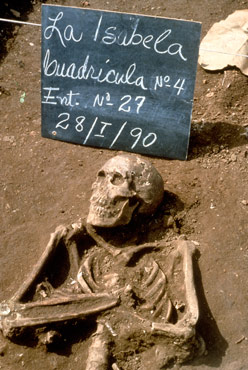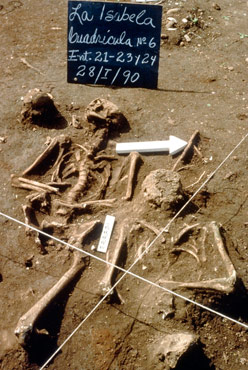
Caption: Skeletons that may represent the remains of crew members from Columbus' second excursion to the New World in 1493-94 were exhumed in 1990 by archaeologists from Italy and the Dominican Republic. The burials were a part of La Isabela on the island of Hispaniola, now a part of the Dominican Republic and that was the first European settlement in the New World. Now, a chemical analysis by University of Wisconsin-Madison archaeologist T. Douglas Price and colleagues of the teeth of these skeletons promises details of the individuals early life history, showing where they were born and what they ate, information that promises to reveal new clues about the first European explorers of the New World.
Photo: Fernando Luna Calderon, provided courtesy of T. Douglas Price
Date: circa early 1990s
High-resolution JPEG

Caption: Skeletons that may represent the remains of crew members from Columbus' second excursion to the New World in 1493-94 were exhumed in 1990 by archaeologists from Italy and the Dominican Republic. The burials were a part of La Isabela on the island of Hispaniola, now a part of the Dominican Republic and that was the first European settlement in the New World. Now, a chemical analysis by University of Wisconsin-Madison archaeologist T. Douglas Price and colleagues of the teeth of these skeletons promises details of the individuals early life history, showing where they were born and what they ate, information that promises to reveal new clues about the first European explorers of the New World.
Photo: Fernando Luna Calderon, provided courtesy of T. Douglas Price
Date: circa early 1990s
High-resolution JPEG

